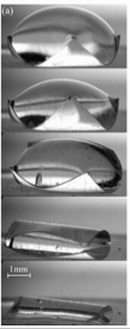April 25, 2007 feature
Folding silicone: building on the microscale

“With classical tools, it is hard to manipulate something so tiny as on the microscale or the nanoscale,” Charlotte Py tells PhysOrg.com. “But here we show how you can use a small drop of water as a micro-wrench to bend planar templates into three-dimensional structures.”
Py is a scientist currently at the University of Paris 7, but the work on capillary folding of elastic sheets was carried out as a collaboration between Physique et Mécanique des Milieux Hétérogènes (PMMH), ESPCI and the Laboratoire d’Hydrodynamique at École Polytechnique. The results are published on Physical Review Letters in a piece titled “Capillary Origami: Spontaneous Wrapping of a Droplet with an Elastic Sheet.”

Py and her coauthors, Paul Reverdy and Charles Baroud at École Polytechnique, and Lionel Doppler, José Bico, and Benoît Roman at PMMH-ESPCI, performed experiments showing how capillary forces can be used to create shapes on the microscale. Capillary forces describe the ability of a substance (in this case water) to draw another substance to it. “This is the first time capillary forces have been used to bend planar templates into something that’s three dimensional. Until now, capillary forces have mainly been used to assemble objects in 2D, for instance at the surface of water.”
The experiment makes use of silicone rubber, which is flexible. “We make thin sheets of silicone,” Py explains, “and we cut them into different shapes, such as flowers, triangles or squares, depending on what we want to build. Then we add a drop of water. Water droplets tend to minimize contact with air, so the drop immediately starts to wrap itself in the sheet.” As the droplet begins to evaporate at room temperature, the wrapping becomes tighter and tighter, until the structure is formed. “Because this happens spontaneously, there is no need to manipulate the process after putting the water on the sheet.”
Py points out the additional results of this work: “One funny thing is that action of capillary forces on small structures was well known. But it has been seen as a problem because it can cause damage. Microstructures such as microcantilevers used in air bag sensors sometimes collapse due to moisture. Now we are showing how to build something using capillary forces. What was once seen only as an inconvenience appears now to have a benefit.”
“Additionally,” Py continues, “this is interesting from a fundamental point of view. The way you fold a two dimensional sheet into three-dimensional objects raises questions of differential geometry. For instance, wrapping a sphere with a sheet is impossible without crumpling, tearing or stretching the sheet.” (Py points out that this is the essence of Gauss’ classical theorema egregium.)
Ultimately, Py and her colleagues hope that this process can be used in microscale mass production. “This can be used to produce very, very small objects,” she says. “We performed the experiment at a one or two millimeter size, but it is based on techniques that are easy to downscale to even smaller sizes.” Applications of this wrapping technology have the potential to enhance the ability to build microstructures, as well as be included in some systems, such as components in electromechanical devices.
Copyright 2007 PhysOrg.com.
All rights reserved. This material may not be published, broadcast, rewritten or redistributed in whole or part without the express written permission of PhysOrg.com.




















